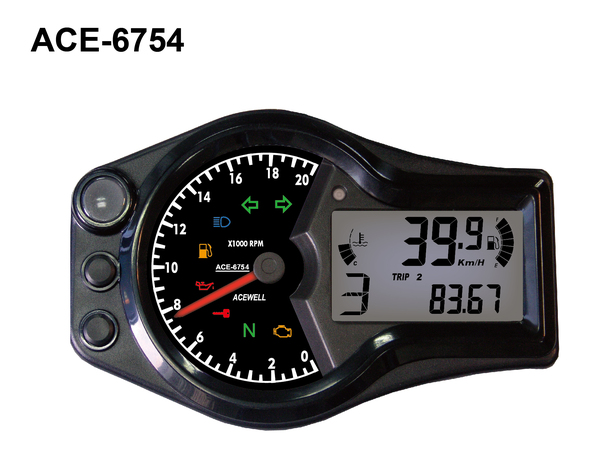Expert Tips for Keeping and Calibrating Your Tachometer
Expert Tips for Keeping and Calibrating Your Tachometer
Blog Article
The Significance of a Tachometer in Keeping Track Of Engine Speed and Performance in Automotive Applications
In the realm of automotive design, the tachometer stands as a critical instrument in the vehicle driver's toolbox, offering a straight window into the internal functions of a vehicle's engine. Past its feature as a plain gauge of transformations per minute (RPM), the tachometer serves as a crucial device for enthusiasts and professionals alike, providing real-time understandings right into engine performance and health. Recognizing the relevance of this tool exceeds surface-level monitorings, diving right into the complex relationship in between engine speed, power output, and general driving experience. As we check out the complex duty of the tachometer in vehicle applications, a deeper appreciation for its influence on automobile dynamics and efficiency starts to emerge.
Importance of Keeping Track Of Engine RPM
Monitoring engine RPM, or transformations per min, is an important facet of automotive upkeep and efficiency analysis. Engine RPM straight correlates with the speed at which the engine's crankshaft rotates, indicating just how swiftly the engine is running - tachometer. By checking RPM, technicians can analyze the wellness of the engine, spot potential concerns, and fine-tune efficiency. An unusual RPM reading may indicate problems such as engine misfires, malfunctioning ignition system, or issues with the gas delivery system. Continually high RPM readings can show hostile driving habits or the demand for a higher equipment shift to enhance fuel performance.
Moreover, keeping an eye on engine RPM is important for performance assessment in auto racing and high-performance automobiles. Keeping optimum RPM degrees is essential for accomplishing peak power output and acceleration. Racers typically utilize tachometers to ensure they are operating within the perfect RPM variety for maximum performance. In recap, keeping track of engine RPM is not only important for identifying issues but additionally for maximizing engine efficiency in numerous auto applications.

Benefits of Real-Time Information
In automotive applications, real-time data plays a vital duty in offering instantaneous insights into the efficiency and condition of the vehicle. By continuously keeping an eye on numerous specifications such as engine speed, temperature level, gas consumption, and a lot more, real-time data provides many benefits that add to boosted effectiveness and security on the road.
In addition, real-time data facilitates efficiency optimization by giving prompt browse around this site feedback on driving habits and engine efficiency. Vehicle drivers can change their habits in real-time based on this information to accomplish much better fuel economic situation and lengthen the life expectancy of their automobile.

Additionally, real-time information plays an essential duty in contemporary auto diagnostics, making it possible for technicians to quickly detect and resolve malfunctions. This results in lowered downtime, lower upkeep prices, and inevitably, boosted general vehicle reliability and durability (tachometer). By utilizing the power of real-time data, auto stakeholders can make enlightened choices that positively impact both the efficiency and long life of the lorry
Effect On Equipment Shifts
The tachometer plays a crucial role in optimizing gear changes by supplying real-time engine rate data to the chauffeur. When approaching the redline on the tachometer, it signals the driver to upshift to avoid over-revving the engine and creating prospective damages.
In addition, the tachometer aids in achieving smoother equipment changes, especially in hands-on transmissions. By keeping track of engine rate, drivers can execute gear changes at the optimum RPM array, minimizing jerking activities and minimizing wear on the transmission elements. This accuracy in gear modifications not just improves driving site web convenience yet likewise contributes to sustain efficiency.
Enhancing Gas Efficiency
Offered the crucial duty the tachometer plays in maximizing gear shifts for performance and engine health, it straight contributes to optimizing gas effectiveness in auto applications. By providing real-time responses on engine speed, the tachometer helps drivers in preserving one of the most efficient RPM array for fuel economic climate. When chauffeurs consistently check the tachometer and readjust their driving behaviors as necessary, they can prevent unneeded gas intake triggered by over-revving or lugging the engine.
Additionally, the tachometer assists vehicle drivers recognize the most fuel-efficient gear to be in at any provided moment, protecting against the engine from working more challenging than needed. In final thought, the tachometer offers as a useful tool in boosting gas efficiency by promoting optimal driving habits and determining areas for improvement in the automobile's performance.

Taking Full Advantage Of Engine Long Life
The tachometer's function in keeping an eye on engine speed and efficiency is crucial in making sure the longevity of automotive engines. Keeping an eye on the tachometer permits vehicle drivers to remain within the suggested RPM array for their vehicle, avoiding unneeded stress on the engine and prolonging its lifespan.

Conclusion
Finally, the tachometer plays an important function in keeping track of engine speed and efficiency in automobile applications. By supplying real-time information on RPM, it permits for efficient gear changes, enhanced gas efficiency, and made best use of engine long life. This device is important for maintaining optimal engine efficiency and making sure the overall capability of a car.
Report this page